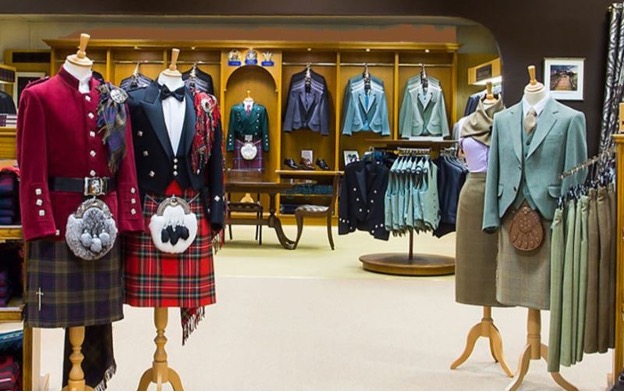The Scottish National Tartan is a symbol of unity and collective heritage that transcends the traditional clan affiliations deeply rooted in Scottish culture. Unlike clan-specific tartans, which represent individual family lineages, the Scottish National Tartan is designed to embody the identity of the entire nation. Its pattern and colors are carefully chosen to reflect the natural beauty and historical legacy of Scotland, incorporating elements that evoke the country’s landscapes and storied past. Officially recognized and often worn during national celebrations such as St. Andrew’s Day and Burns Night, the Scottish National Tartan serves as a unifying emblem for all Scots, both within Scotland and across the global diaspora. It signifies a shared cultural heritage and national pride, connecting individuals to their collective roots regardless of their specific ancestry. This tartan is also registered with the Scottish Register of Tartans, ensuring its authenticity and preserving its design for future generations. Through its rich symbolism and wide acceptance, the Scottish National Tartan continues to play a crucial role in fostering a sense of belonging and identity among Scots everywhere, celebrating the enduring spirit and unity of Scotland.
Origins of Tartan
The origins of tartan fabric can be traced back to ancient times, though its precise beginnings are somewhat shrouded in mystery. Early forms of tartan were simple checks and stripes woven into woolen cloth. Archaeological findings, such as the Falkirk tartan dating back to the 3rd century AD, suggest that tartan-like patterns were used by the Celts who inhabited what is now Scotland.
The word “tartan” itself is derived from the French word “tiretain,” meaning a type of cloth, which in turn comes from the Old Spanish tiritana. These linguistic roots hint at the fabric’s journey through different cultures before it became distinctly Scottish. By the 16th century, tartan had become widely recognized in Scotland, with patterns or “setts” representing different regions, clans, and families.
The Evolution of the Scottish National Tartan
The concept of a Scottish National Tartan, as we understand it today, evolved over time. Initially, tartans were more regionally and family-oriented. The formalization of clan tartans can be largely attributed to the Victorian era and the romanticization of Scottish culture. Sir Walter Scott, a Scottish historical novelist, played a significant role in this revival. His organization of King George IV’s visit to Scotland in 1822 emphasized traditional Highland dress, solidifying the association of specific tartans with clans.
In 1855, the Highland Society of London began registering tartans, further formalizing their use. The notion of a national tartan emerged as Scotland sought a unifying symbol that transcended clan affiliations. The Scottish National Tartan, often recognized today, symbolizes the unity and collective heritage of Scotland, representing all Scots rather than any single group.
Weaving Tradition: The Craft of Tartan Fabric
The process of weaving tartan fabric is a meticulous and intricate craft, combining traditional techniques with modern innovations. The foundation of tartan weaving lies in the use of a loom, where threads of different colors are interlaced to create the characteristic checkered patterns. The sequence and color of the threads determine the “sett” of the tartan.
Materials and Dyes
Historically, tartan was woven from wool, a readily available material in Scotland. The quality of the wool and the skill of the weaver were critical in producing a durable and visually appealing fabric. Natural dyes derived from plants, minerals, and insects were used to color the threads. Madder root, woad, and cochineal were common sources of red, blue, and green dyes, respectively.
With the advent of synthetic dyes in the 19th century, a broader and more consistent palette of colors became available, allowing for greater variation in tartan patterns. However, many traditional weavers continue to use natural dyes to maintain authenticity and connection to the past.
The Weaving Process
The weaving process begins with the preparation of the warp and weft threads. The warp threads are stretched vertically on the loom, while the weft threads are interwoven horizontally. The specific order and color sequence of these threads create the distinctive tartan pattern.
Traditional handlooms require the weaver to manually pass the weft threads through the warp, a labor-intensive process that demands precision and expertise. Modern power looms have streamlined this process, enabling the production of tartan fabric on a larger scale. Despite these technological advancements, the fundamental principles of tartan weaving remain unchanged.
Pattern and Registration
Each tartan pattern is defined by its “set,” the specific sequence of colors and thread counts. The set is repeated both horizontally and vertically, creating a symmetrical design. The complexity of a tartan can vary from simple two-color patterns to intricate multi-colored designs.
The Scottish Register of Tartans, established in 2008, serves as an official repository for all known tartans. It ensures that each registered tartan is unique and maintains records of the patterns, colors, and historical information associated with them. This registry helps preserve the cultural heritage and provides a valuable resource for those seeking to create or research tartan designs.
Cultural Significance of Tartan
Tartan holds a deep cultural significance for Scotland and its people. It is more than just a pattern; it is a symbol of identity, heritage, and pride. Each tartan carries a story, whether it represents a clan, a region, or a national identity. Wearing tartan connects individuals to their ancestors and the history of Scotland.
Clan Tartans
Clan tartans are perhaps the most well-known type of tartan. Each Scottish clan, a kinship group with shared ancestry, has its own distinctive tartan pattern. These patterns were used to signify allegiance and identity, especially during gatherings and battles. The tradition of clan tartans has been preserved over centuries, with many Scots today proudly wearing the tartan of their forebears.
Clan tartans are often worn during formal occasions such as weddings, funerals, and Highland games. The kilt, a traditional Scottish garment, is commonly made from clan tartan fabric and is an iconic representation of Scottish culture.
Regional and District Tartans
In addition to clan tartans, there are regional and district tartans that represent specific areas within Scotland. These tartans celebrate the unique characteristics and heritage of different regions. For instance, the Isle of Skye has its own tartan, reflecting the island’s distinctive culture and landscape.
These tartans are often used in local celebrations and events, fostering a sense of community and regional pride. They serve as a reminder of the diverse cultural tapestry that makes up Scotland.
National Tartan
The Scottish National Tartan is a relatively modern creation, designed to represent the nation as a whole rather than any specific clan or region. This tartan embodies the collective identity of the Scottish people, transcending individual affiliations. It is often worn during national celebrations such as St. Andrew’s Day and Burns Night, as well as by Scots living abroad who wish to express their heritage.
The colors and pattern of the Scottish National Tartan are carefully chosen to reflect the natural beauty and historical legacy of Scotland. It serves as a unifying symbol, reminding Scots of their shared history and cultural heritage.
Tartan in Contemporary Fashion and Culture
Tartan fabric has transcended its traditional roots to become a versatile and fashionable material in contemporary culture. Designers and fashion houses around the world have embraced tartan, incorporating it into their collections in innovative ways. This global recognition has helped to elevate tartan from a symbol of Scottish heritage to an international fashion statement.
High Fashion and Tartan
Leading fashion designers such as Vivienne Westwood, Alexander McQueen, and Ralph Lauren have all utilized tartan in their collections. These designers have reinterpreted tartan, blending traditional patterns with modern styles to create unique and striking garments. Tartan fabric has been used in everything from tailored suits and dresses to accessories and footwear.
The appeal of tartan in high fashion lies in its versatility and rich history. The juxtaposition of traditional patterns with contemporary designs creates a dynamic and visually appealing aesthetic. This fusion of old and new resonates with fashion enthusiasts who appreciate the blend of heritage and modernity.
Tartan in Popular Culture
Tartan has also made its mark in popular culture, appearing in films, music, and everyday fashion. Iconic films like “Braveheart” and “Outlander” have showcased tartan-clad characters, further cementing its association with Scottish identity. Musicians such as Rod Stewart and The Bay City Rollers have famously worn tartan outfits, contributing to its popularity in the music industry.
In everyday fashion, tartan remains a popular choice for casual and formal wear. Tartan skirts, scarves, and jackets are commonly seen on the streets, reflecting the fabric’s enduring appeal. The versatility of tartan allows it to be styled in numerous ways, making it a staple in wardrobes around the world.
Preserving and Promoting Tartan Heritage
Efforts to preserve and promote tartan heritage are crucial in ensuring that this iconic fabric continues to thrive for future generations. Various organizations, museums, and events play a vital role in maintaining the cultural significance of tartan and educating the public about its history and importance.
The Scottish Tartans Authority
The Scottish Tartans Authority (STA) is dedicated to preserving, promoting, and protecting Scotland’s tartan heritage. Established in 1996, the STA maintains a comprehensive database of tartans, providing valuable resources for researchers, designers, and enthusiasts. The organization also offers educational programs and collaborates with weavers and manufacturers to ensure the quality and authenticity of tartan fabric.
Tartan Museums and Exhibits
Museums and cultural institutions in Scotland and beyond showcase tartan through dedicated exhibits and collections. The National Museum of Scotland, for example, features a vast array of tartan artifacts, including historical garments, textiles, and accessories. These exhibits offer visitors an in-depth look at the evolution of tartan and its significance in Scottish culture.
Temporary exhibits and traveling shows also help to bring tartan to a wider audience. By highlighting the artistry and history behind tartan, these exhibitions foster a deeper appreciation for this iconic fabric.
Tartan Festivals and Events
Tartan festivals and events celebrate the cultural heritage of tartan and provide a platform for showcasing traditional and contemporary uses of the fabric. The Royal Edinburgh Military Tattoo, held annually at Edinburgh Castle, is one of the most renowned events featuring tartan. Performers from around the world don tartan attire, celebrating Scotland’s military history and cultural traditions.
Highland games, held throughout Scotland and in many countries with Scottish communities, also prominently feature tartan. These events include athletic competitions, music, dance, and displays of traditional Scottish dress, with participants proudly wearing their clan tartans.
Conclusion
The Scottish National Tartan is more than just a fabric; it is a powerful symbol of Scotland’s rich cultural heritage and identity. From its ancient origins to its modern-day significance, tartan has woven its way into the hearts of Scots and people around the world. The intricate craft of tartan weaving, the cultural significance of clan and regional tartans, and the global recognition of tartan in fashion and popular culture all contribute to its enduring legacy.
Efforts to preserve and promote tartan heritage ensure that this iconic fabric continues to thrive, connecting past, present, and future generations. Whether worn as a symbol of clan allegiance, regional pride, or national identity, tartan remains a vibrant and cherished emblem of Scotland, celebrating the unique and enduring spirit of its people.
Stay in touch to get more updates & news on Tribune Breaking!







